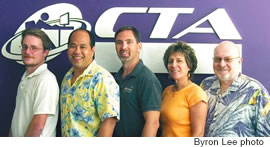A Telecommuting Solution

These smiling CTA employees are (from left): Jeff
Burbank, Bert Lee, Dan Marvin, Harriet Bloom and
Mike Meyer
As a business executive with a company based on Oahu, I’m not immune to the traffic travails that our employees cope with on a daily basis. In this instance, we really do feel their pain.
As we enter into the latest round of arguments about mass transit in Hawaii, I have to say I’m getting tired of the same old battles. Having watched this cycle of complaint, accusations, counter-claims and the eternal quest for federal dollars for the last 35 years, I can guarantee that even a trillion-dollar system won’t speed up our commute.
A study released by Randal O’Toole of the Cato Foundation shows that total inflation-adjusted subsidies to transit - buses and trains - have more than doubled since 1990, yet total ridership has increased by less than 10 percent. By comparison, urban driving nationally has increased by 42 percent.
This is reflected in Hawaii, too. The whole concept of Kapolei was to create an alternative site to distribute population and work in order to help daily traffic into downtown Honolulu. Now one of the worst traffic areas on the island is (you guessed it) Kapolei. We need to rethink this whole thing before we struggle to squander several hundred million in tax money on another round of failed rail solutions. I believe we have the mass transit solution in hand yet fail to recognize it.
One of the most significant social revolutions that could be spawned by the Internet was recognized in the early 1990s as telecommuting. If most of your work is done on a desktop computer, why not do it from home with high speed Internet connections? Why struggle to get downtown to sit at the same type of computer that you have at home?
The model for this has transformed education in the University of Hawaii system. Almost all UH community college courses are now available online. As a part time faculty member at Leeward Community College, I have been teaching exclusively online since 1998. I don’t go to the campus unless there’s a special reason.
Neither do my students. Many of them are working mothers with no time to drive to campus for classes. Over the last five years it has become obvious that campus communities are turning virtual and that, maybe, we don’t need to drive to class and listen to a canned lecture just so we can drive home again.
Telecommuting isn’t a new idea for Hawaii. In 1989 the state funded a 12-month telecommuting demonstration project that showed how it works. Of course the clincher for our community is less roadway congestion, reduced auto emissions and greater economic competitiveness. Telecommuting is already working in Arizona where about 3,400 workers telecommute.
Hawaii has over 70,000 state and county workers making significant impacts on our commuting patterns. If state, county and private employers allowed people to work at home for a few hours each morning it would reduce traffic on H-1 drastically.
For colleges, universities, corporate education and grade schools, the physical classroom is being augmented by virtual classrooms that are more efficient. The same techniques must be applied to private businesses, nonprofit organizations and government.
Interestingly, one of the last disadvantages to working from home is disappearing. Employers used to argue that employees needed to be at the place of business to answer the phone. As more companies install Voice Over IP phone systems the office phone can go home with you.
The answer to our traffic woes does not lie in billion-dollar, make-work subsidies or spiffy new monorail systems. The answer is leveraging the high speed Internet connections that already link our homes and offices to the outside world.
Next Week: Mira and Arun Savora, L.A. Weight Loss Centers Hawaii
E-mail this story | Print this page | Comments (0) | Archive | RSS Comments (0) |
Most Recent Comment(s):




 Del.icio.us
Del.icio.us








